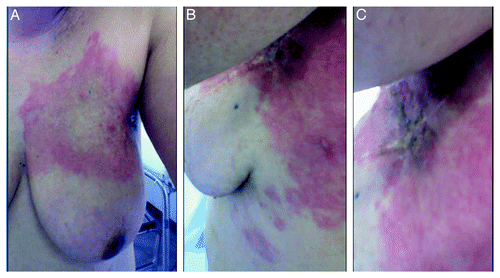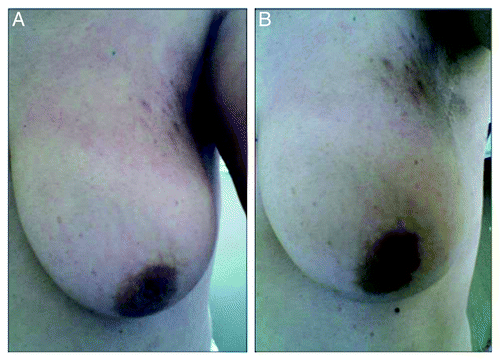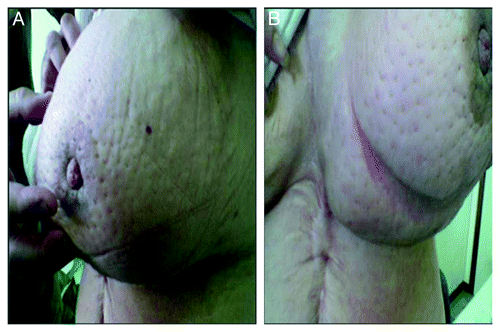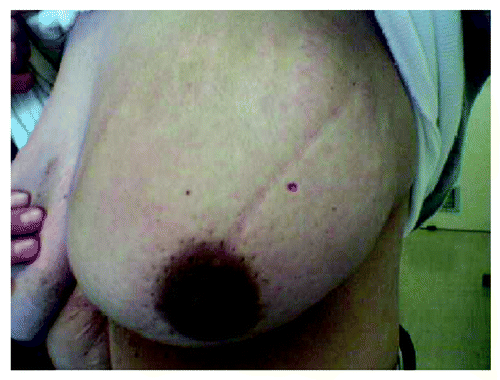Abstract
Breast carcinoma (BC) is a heterogeneous disease in terms of histology, therapeutic response, dissemination patterns to distant sites and patient outcomes. Triple-negative breast cancer (TNBC), defined by the lack of protein expression of estrogen and progesterone receptors and the absence of HER2 protein overexpression (ER–/PR–/HER2–) has significant clinical implications due to their poor prognosis and the lack of targeted agents. Skin involvement is one of the most distressing presentations of locally recurrent breast cancer and few studies have identified effective agents in this setting. In fact, the increasing use of anthracycline/taxane-based chemotherapy in the neoadjuvant and/or adjuvant settings has led to investigate new cytotoxic therapies such as the combination of pegylated liposomal doxorubicin (PLD) with gemcitabine. Here, we report two cases of disseminated TNBC with extensive cutaneous metastases and a remarkable response to PLD in combination with gemcitabine. Further investigations are needed to confirm the efficacy of this regimen in skin involvement and TNBC.
Introduction
Breast carcinoma is a heterogeneous disease in terms of histology, therapeutic response, dissemination patterns to distant sites and patient outcomes. Gene expression analyses have defined different tumor subtypes (Luminal A, Luminal B, HER2-enriched and Basal-like) with significant prognostic and treatment implications. Among them, Basal-like tumors have been associated with a poor prognosis and a triple-negative phenotype which is defined by the lack of protein expression of the estrogen and progesterone receptors and the absence of HER2 protein overexpression (ER–/PR–/HER2–).Citation1 Importantly, approximately 170,000 breast cancers diagnosed annually worldwide have a triple-negative phenotype.Citation2
Several studies have described patterns of metastasis according to the major breast cancer intrinsic molecular subtypes.Citation3,Citation4 Among them, Basal-like and/or triple-negative tumors have distinct patterns of relapse with higher incidence of lung, brain and distant nodal metastases than Luminal A and B subtypes and/or ER-positive disease.Citation4 However, due to its low frequency, there is a substantial lack of data regarding the frequency of skin involvement across the molecular subtypes.
The increasing use of chemotherapy particularly anthracycline- and taxane-based regimens in the neoadjuvant and adjuvant setting have led to investigate new cytotoxic agents and combinations, particularly in TNBC since no approved targeted therapies exists to date. For example, the efficacy and tolerability of pegylated liposomal doxorubicin (PLD) in combination with gemcitabine (GEM) has been evaluated in several studies.Citation5-Citation8 However, a specific activity of this combination on skin involvement and/or on TNBC has not been previously reported. Here, we describe two cases of TNBC with extensive cutaneous metastases with a remarkable response to PLD-GEM combination.
Clinical case 1
A 48-y-old woman was referred to our institution in March 2006 with a breast cancer recurrence rapidly evolving at the surgical scar that was characterized by erythema and cutaneuos nodules, together with painful axillary adenopathies and functional impotence of the left arm. Four years before she had undergone a left quadrantectomy of the upper outer quadrant and axillary nodal dissection. Histopathological analysis of the surgical specimen revealed the presence of a grade 3 infiltrating ductal carcinoma with focal positivity of hormonal receptors, negative HER2 status and 15/31 positive lymph nodes. Adjuvant radiation therapy followed by chemotherapy consisting of epirubicin and docetaxel were administered. In March 2003, tamoxifen citrate and the analog leuprolide acetate were started. No relevant family history or other significant medical conditions were recorded.
In February 2006, the patient noticed the appearance of erythema of the superior left breast skin and in the scar area. On physical examination, the erythema extended until posterior axillary line and presented some small cutaneous nodules located in continuity with the surgical scar (). In addition, painful, fixed adenopathies were palpated in the left axilla. Bone scan was normal. A CT scan of the chest and the abdomen showed a large (~4 cm) conglomerate of lymph nodes behind the left pectoral muscle and the presence of a hepatic lesion, which was confirmed by ultrasonography. Core biopsy of an axillary lymph node was performed and a massive metastasis from TNBC with a high Ki-67 of 35% of positive cells was identified.
Patient was enrolled in our previously reported phase II studyCitation7 that evaluated PLD (25 mg/m2 on day 1) and GEM (800 mg/m2 on days 1 and 8) combination every 21 d. After two cycles, a remarkable improvement of skin involvement was observed that continued until complete resolution after cycle 4 ().
Ultrasonography showed the disappearance of the hepatic lesion and a CT scan reported a partial reduction of the lymph nodes metastases. A complete clinical and radiological remission was achieved after six cycles, and a total of 12 cycles were given. During the treatment course, the only toxicity reported was grade 2 leucopenia and trombocitopenia. No change of the basal LVEF was recorded (60%). After 10 mo, a progression of the disease was documented in the liver, and weekly paclitaxel was administered. After 3 cycles treatment was interrupted for worsening of clinical condition due to liver dysfunction. Patient’s overall survival from diagnosis was 19 mo.
Clinical case 2
On August 2006, a 40-y-old woman was admitted in our institution for the presence of a left breast mass. Her previous clinical history was marked by a cognitive and behavioral sequelae following surgical excision of a grade III cerebellar astrocytoma and postoperative radio-chemotherapy 24 y earlier. In addition, she underwent nefrectomy in 1972 after an abdominal trauma. The clinical breast examination showed an increased dimension of the left breast due to the presence of a mass measuring 19 × 12 cm and that extended to all four quadrants, together with swelling, redness and peau d’orange (i.e., skin edema) with nipple retraction (). Several painful, fixed and large lymph nodes (~3.5 cm) were identified in the left axilla. A mammography and ultrasonography confirmed the presence of a retroareolar 37 mm lesion with carcinomatous mastitis. Chest radiography, abdominal ultrasonography and bone scan were normal. Heart examination, ECG and echocardiography were regular with LVEF of 71%.
Core biopsy of the tumor was performed and a high grade triple-negative invasive ductal carcinoma was diagnosed with a Ki67 of 25%. In consideration of her cognitive and behavioral difficulties, together with the patient’s request to avoid alopecia, a first line treatment with PLD and GEM was administered for 6 cycles from September 2006 to January 2007 using the previously described dose schedule. The only toxicities reported were grade 2 leucopenia and a 10% reduction in LVEF.
After three cycles, a remarkable improvement of the cutaneous metastases was observed that continued during the additional cycles with a complete resolution at the end of the treatment (). Consistent with the response in the skin, a breast MRI, mammography and ultrasonography showed a mass reduction of about 80% with the current involvement only of upper outer quadrant. Consequently, she underwent left quadrantectomy of the upper outer quadrant and axillary node dissection. Histopathologic analyses of the tumor specimen revealed the presence of a grade 3 infiltrating TNBC with 16/16 positive lymph nodes (T2N3aM0) and a Ki67 of 25% was identified. Standard adjuvant radiation therapy was given and the patient was followed periodically.
After 12 mo of follow-up, a retroareolar recurrence in left breast with bilateral erythema and axillary adenopathies appeared. The mammography also revealed the presence of a small lesion in right breast. The cytological or histological characterization of the right lesion was not performed because of patient’s refusal. In consideration of the previous response to PLD and GEM, 3 additional cycles were given obtaining a stable disease and a rapid improvement of the skin involvement. Grade 2 hematological toxicities were recorded and due to the patient’s poor compliance treatment was stopped. After only 3 mo the skin involvement was massive and a progression to the lung and brain parenchyma was documented. Overall survival from diagnosis was 31 mo.
Discussion
The optimal management of metastatic BC remains a significant therapeutic challenge, especially TNBC, which are biologically aggressive, show a poor prognosis, and no targeted and effective treatments exists. TNBCs show specific molecular alterations including a high rate of p53 mutations, frequent loss of function of BRCA1,Citation9 phosphatase and tensin homolog (PTEN) lossCitation10 and a specific panel of tyrosine kinase activation [fibroblast growth factor receptor 2 (FGFR2)]. Most TNBC are positive for cytokeratins (CK) 5/6, CK 14 and CK 17, and express markers of a high proliferationCitation2 such as KI67. Interestingly, TNBCs are considered sensitive to chemotherapy in general, as shown by the high response rates of primary tumors to neoadjuvant chemotherapy. However, those TNBCs that do not achieve a complete pathological response after chemotherapy show a high risk of recurrence.Citation11 When metastatic, TNBC is aggressive and drug resistant, leading to cancer death within < 12–24 mo for the majority of patients.Citation12
Different therapeutic approaches are being investigated. Inhibitors of the DNA-repair Poly(ADP ribose) polymerase 1 (PARP1) protein have shown to induce tumor response as a single agent in BRCA-deficient breast cancer.Citation13 These agents could help sensitize DNA-damaging cytotoxic agents such as cisplatinum in the entire triple-negative population. However, the cautious optimism generated by results of a phase II study of the PARP inhibitor iniparib in combination with carboplatin and gemcitabine in women with triple-negative metastatic breast cancerCitation14 was not confirmed in a large phase III trial.Citation15
Several other targeted agents are being developed in TNBC, including inhibitors of the epidermal growth factor receptor (EGFR), FGFR2, mammalian target of rapamycin (mTOR) and angiogenesis.Citation12 Although 50% of TNBCs overexpress EGFR, the use of EGFR inhibitors as single agents in patients with unselected and triple-negative metastatic breast cancers has produced disappointing results.Citation16 Patients with TNBCs have shown increased blood levels of vascular endothelial growth factor (VEGF), and these were associated with shorter survival. Angiogenesis is therefore regarded as a key target for the development of new therapeutic strategies for TNBC. Miller et al. demonstrated a significant improvement in progression-free survival when adding bevacizumab, a monoclonal antibody targeting VEGF, to paclitaxel chemotherapy compared with single-agent paclitaxel alone in first-line treatment of metastatic disease.Citation17 An analysis on the TNBC subset of patients confirmed the same survival benefit (HR = 0.53; 95% confidence interval, 0.40–0.70).Citation2
Although many progresses are being made, chemotherapy still remains the best choice for TNBC. Anthracyclines and taxanes are among the most active agents for breast cancer, diffusely used either in the metastatic setting or in the neoadjuvant and adjuvant therapy. Moreover, preclinical and clinical studies indicate that tumors with BRCA1 dysfunction are sensitive to agents that cause DNA damage, such as platinum agents (cisplatin and carboplatin).Citation18 Clinical trials aiming to address the response of TNBC to platinum agents are underway, including investigations in phase II and III.
The rational for combining PLD and GEM is based on their single-agent activities in metastatic breast cancer, the different mechanisms of action of the two drugs, which have been shown to be synergistic in vitro and in vivo models,Citation19,Citation20 as well as the non-overlapping toxicity profiles. The efficacy and tolerability of both agents in combination has been successfully investigated in recurrent/metastatic breast cancer patients in several phase II studies, with an overall response rate of 26–52%, and a median time-to-tumor progression of 4.5–11 mo, together with an acceptable toxicity profile.Citation5-Citation8
Skin involvement is one of the most distressing presentations of locally recurrent breast cancer, which remains the most common tumor to metastasize to the skin. In a retrospective review 164 cases of skin metastases from breast carcinoma were examined to determine the most common clinical and histopathological presentations. The most frequent presentations are papules and/or nodules (80%), followed by teleangiectatic carcinoma (11.2%), erysipeloid carcinoma (3%), “en cuirasse” carcinoma (fibrotic-type cutaneous metastatic spread to the trunk described as an “encasement of armor”) (3%), alopecia neoplastica (2%) and zosteriform pattern (0.8%).Citation21 The anterior part of the chest and the previous mastectomy scare are the most common site of cutaneous breast cancer involvement. Additional common areas are head, neck, scalp, abdomen and upper extremities.
Surgical excision, radiotherapy or intralesional chemotherapy can be used in solitary lesions, but all having their limitations. Systemic chemotherapy is the most commonly used treatment and the choice of the regimen depends on the characteristics of the patient and the previous treatments. PLD chemotherapy, also used in Kaposi’s sarcoma, has shown in combination with hyperthermia to be active against skin metastases of breast carcinoma.Citation22 The mechanism of action of PLD on skin lesions remains unclear but some peculiar histological characteristics as the tortuous vascularity with sequestering of blood in some tumors suggest a way in which treatment might be directed toward the skin lesions.Citation23 Although the activity of the combination of PLD with GEM in breast cancer treatment has been well investigated, our observations specifically suggest the interesting efficacy of this regimen on skin involvement. Moreover, to our knowledge, this is the first report to specifically describe the activity of this combination in TNBC. Further investigations are needed to better investigate the genetic characteristics that correlate with skin involvement across the different breast cancer subtypes and verify the possible role of this combination in TNBC.
Disclosure of Potential Conflicts of Interest
No potential conflicts of interest were disclosed.
References
- Adamo B, Anders CK. Stratifying triple-negative breast cancer: which definition(s) to use?. Breast Cancer Res 2011; 13:105; http://dx.doi.org/10.1186/bcr2852; PMID: 21457488
- Ismail-Khan R, Bui MM. A review of triple-negative breast cancer. Cancer Control 2010; 17:173 - 6; PMID: 20664514
- Harrell JC, Prat A, Parker JS, Fan C, He X, Carey L, et al. Genomic analysis identifies unique signatures predictive of brain, lung, and liver relapse. Breast Cancer Res Treat 2011; In press http://dx.doi.org/10.1007/s10549-011-1619-7; PMID: 21671017
- Kennecke H, Yerushalmi R, Woods R, Cheang MC, Voduc D, Speers CH, et al. Metastatic behavior of breast cancer subtypes. J Clin Oncol 2010; 28:3271 - 7; http://dx.doi.org/10.1200/JCO.2009.25.9820; PMID: 20498394
- Rivera E, Valero V, Arun B, Royce M, Adinin R, Hoelzer K, et al. Phase II study of pegylated liposomal doxorubicin in combination with gemcitabine in patients with metastatic breast cancer. J Clin Oncol 2003; 21:3249 - 54; http://dx.doi.org/10.1200/JCO.2003.03.111; PMID: 12947059
- Fabi A, Ferretti G, Papaldo P, Salesi N, Ciccarese M, Lorusso V, et al. Pegylated liposomal doxorubicin in combination with gemcitabine: a phase II study in anthracycline-naïve and anthracycline pretreated metastatic breast cancer patients. Cancer Chemother Pharmacol 2006; 57:615 - 23; http://dx.doi.org/10.1007/s00280-005-0116-2; PMID: 16163541
- Adamo V, Lorusso V, Rossello R, Adamo B, Ferraro G, Lorusso D, et al. Pegylated liposomal doxorubicin and gemcitabine in the front-line treatment of recurrent/metastatic breast cancer: a multicentre phase II study. Br J Cancer 2008; 98:1916 - 21; http://dx.doi.org/10.1038/sj.bjc.6604409; PMID: 18493232
- Ulrich-Pur H, Kornek GV, Haider K, Kwasny W, Payrits T, Dworan N, et al. Phase II trial of pegylated liposomal doxorubicin (Caelyx) plus Gemcitabine in chemotherapeutically pretreated patients with advanced breast cancer. Acta Oncol 2007; 46:208 - 13; http://dx.doi.org/10.1080/02841860600897868; PMID: 17453371
- Sørlie T, Perou CM, Tibshirani R, Aas T, Geisler S, Johnsen H, et al. Gene expression patterns of breast carcinomas distinguish tumor subclasses with clinical implications. Proc Natl Acad Sci U S A 2001; 98:10869 - 74; http://dx.doi.org/10.1073/pnas.191367098; PMID: 11553815
- Adamo B, Deal AM, Burrows E, Geradts J, Hamilton E, Blackwell KL, et al. Phosphatidylinositol 3-kinase pathway activation in breast cancer brain metastases. Breast Cancer Res 2011; 13:R125; http://dx.doi.org/10.1186/bcr3071; PMID: 22132754
- Carey LA, Dees EC, Sawyer L, Gatti L, Moore DT, Collichio F, et al. The triple negative paradox: primary tumor chemosensitivity of breast cancer subtypes. Clin Cancer Res 2007; 13:2329 - 34; http://dx.doi.org/10.1158/1078-0432.CCR-06-1109; PMID: 17438091
- Berrada N, Delaloge S, André F. Treatment of triple-negative metastatic breast cancer: toward individualized targeted treatments or chemosensitization?. Ann Oncol 2010; 21:Suppl 7 vii30 - 5; http://dx.doi.org/10.1093/annonc/mdq279; PMID: 20943632
- Tutt A, Robson M, Garber JE, Domchek SM, Audeh MW, Weitzel JN, et al. Oral poly(ADP-ribose) polymerase inhibitor olaparib in patients with BRCA1 or BRCA2 mutations and advanced breast cancer: a proof-of-concept trial. Lancet 2010; 376:235 - 44; http://dx.doi.org/10.1016/S0140-6736(10)60892-6; PMID: 20609467
- O’Shaughnessy J, Osborne C, Pippen JE, Yoffe M, Patt D, Rocha C, et al. Iniparib plus chemotherapy in metastatic triple-negative breast cancer. N Engl J Med 2011; 364:205 - 14; http://dx.doi.org/10.1056/NEJMoa1011418; PMID: 21208101
- O'Shaughnessy J, Schwartzberg LS, Danso MA, Rugo HS, Miller K, Yardley DA, et al. A randomized phase III study of iniparib (BSI-201) in combination with gemcitabine/carboplatin (G/C) in metastatic triple-negative breast cancer (TNBC). J Clin Oncol 2011; 29
- Liu T, Yacoub R, Graham T, Yang L, Tighiouart M, O'Regan RM. Effect of mTOR inhibition on sensitivity of triple-negative breast cancer cells to epidermal growth factor inhibition. J Clin Oncol 2009; 27:5153 - 9; PMID: 19752342
- Miller K, Wang M, Gralow J, Dickler M, Cobleigh M, Perez EA, et al. Paclitaxel plus bevacizumab versus paclitaxel alone for metastatic breast cancer. N Engl J Med 2007; 357:2666 - 76; http://dx.doi.org/10.1056/NEJMoa072113; PMID: 18160686
- Sirohi B, Arnedos M, Popat S, Ashley S, Nerurkar A, Walsh G, et al. Platinum-based chemotherapy in triple-negative breast cancer. Ann Oncol 2008; 19:1847 - 52; http://dx.doi.org/10.1093/annonc/mdn395; PMID: 18567607
- Chow KU, Ries J, Weidmann E, Pourebrahim F, Napieralski S, Stieler M, et al. Induction of apoptosis using 2′,2′ difluorodeoxycytidine (gemcitabine) in combination with antimetabolites or anthracyclines on malignant lymphatic and myeloid cells. Antagonism or synergism depends on incubation schedule and origin of neoplastic cells. Ann Hematol 2000; 79:485 - 92; http://dx.doi.org/10.1007/s002770000181; PMID: 11043419
- Gallo D, Fruscella E, Ferlini C, Apollonio P, Mancuso S, Scambia G. Preclinical in vivo activity of a combination gemcitabine/liposomal doxorubicin against cisplatin-resistant human ovarian cancer (A2780/CDDP). Int J Gynecol Cancer 2006; 16:222 - 30; http://dx.doi.org/10.1111/j.1525-1438.2006.00304.x; PMID: 16445637
- Nava G, Greer K, Patterson J, Lin KY. Metastatic cutaneous breast carcinoma: A case report and review of the literature. Can J Plast Surg 2009; 17:25 - 7; PMID: 20190910
- Dvorák J, Zoul Z, Melichar B, Jandík P, Mergancová J, Hrncírová I, et al. Pegylated liposomal doxorubicin in combination with hyperthermia for treatment of skin metastases of breast carcinoma: a case report. Onkologie 2001; 24:166 - 8; http://dx.doi.org/10.1159/000050306; PMID: 11441298
- Harrison M, Tomlinson D, Stewart S. Liposomal-entrapped doxorubicin: an active agent in AIDS-related Kaposi’s sarcoma. J Clin Oncol 1995; 13:914 - 20; PMID: 7707119



